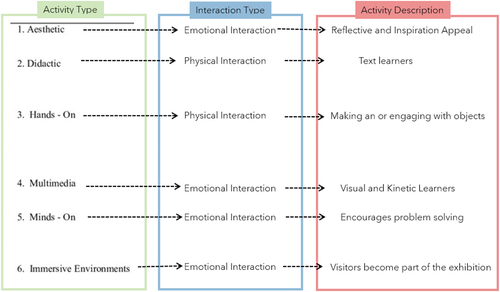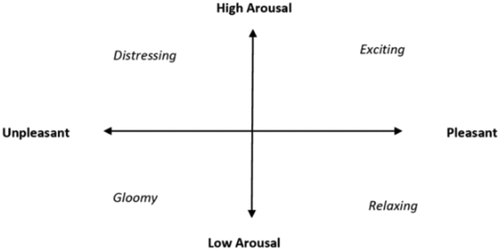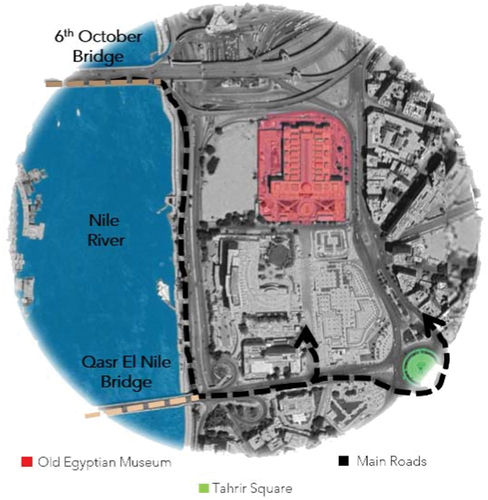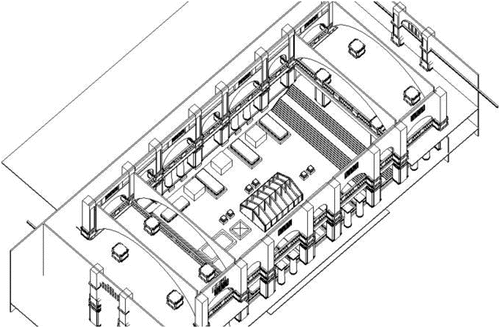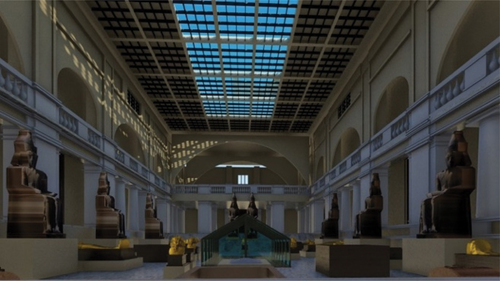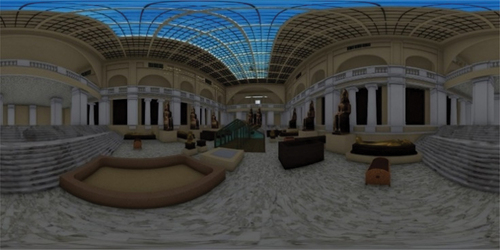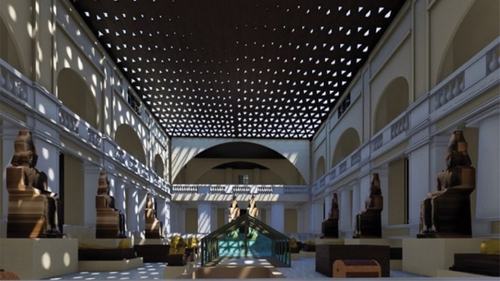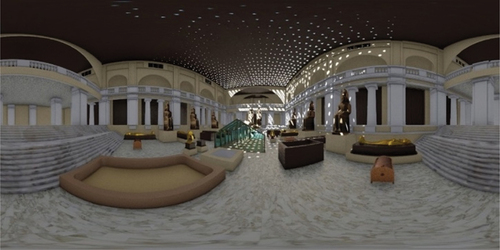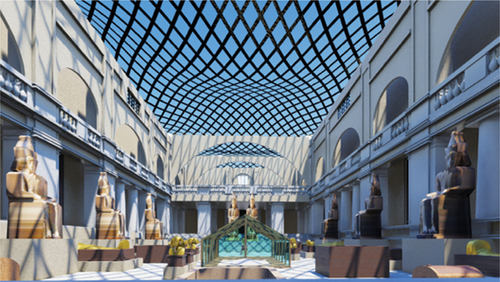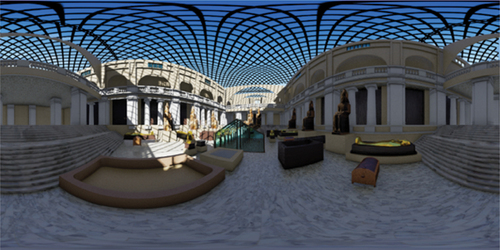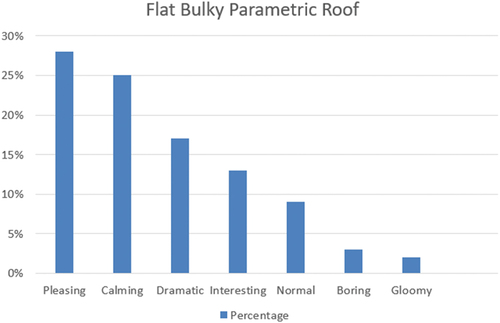ABSTRACT
Previous research indicated that museums have historically prioritized their formal and physical features at the expense of accommodating visitors’ needs which has negatively affected visitors’ museum experience. A shortage in interactive spatial experiences in some historical museums in Egypt led to a decrease in the rate of visits and visitor’s satisfaction. Museums’ interior design has a significant impact on people’s emotions as well as their museum experience. Furthermore, prior research has indicated that parametric design can convey emotional interactive spatial experiences when applied to different interior design elements. Such elements can include the building’s roof, floor, or walls. This research aims to create a set of guidelines for enhancing visitors’ emotional and interactive spatial experiences in historical museums using parametric interior roof design solutions. The research adopted a mixed method approach. A qualitative approach was implemented by reviewing the precedent literature. This was followed by a case study in the Egyptian context and a computer-generated model of the Egyptian Museum in Cairo was developed. Two parametric roof alternatives were tested along with the existing roof of the Egyptian Museum in Cairo by using Virtual Reality on a sample of 67 participants. The quantitative approach was achieved by distributing questionnaires among participants and analyzing the acquired data. The results showed that the application of parametric designs could develop interactive relaxing or engaging museum spatial experiences. This study could benefit architects, interior designers, and relevant specialists in the design process to enhance the museums’ spatial emotional interactive experience by using parametric design.
Introduction
People typically visit museums to learn, do something meaningful or go for a new experience [Citation1]. Since the educational value of museums has grown to be a main concern, museums’ goal should extend from simply preserving the artwork to offering visitors narrative, educational and engaging atmospheres [Citation2]. Over the last century, museums’ target was to attain their spatial character through not only their exhibition halls that signifies the best framework for presenting the displayed items, but also to create an interactive and memorable experience [Citation3]. The need to create more interesting interactive exhibits for visitors while still having their commitment to exhibiting object collections and organizing them for future generations puts history museums in a difficult position [Citation3]. Interactive exhibits and spaces in museums are sometimes thought to be limited to science and technology museums [Citation4]. Even though interaction between visitors, interpreters, and displayed objects is critical for the interactive process, there are few interactive installations in history or cultural museum settings as it is believed that historical objects and collections are too valuable for visitors to interact with [Citation4]. Thus, there is a need for various strategies that apply restricted physical interaction while creating an emotional interaction in historical museums [Citation4].
The lack of interactive elements that engage museum visitors has led to shortened focus spans of visitors and accordingly they become less engaged and intrigued to know the history behind the displayed items [Citation4]. This lack of interaction resulted in a decrease in the learning outcomes of the museum’s visit, unlike an engaging museum experience that allows interacting with the displayed elements and the museum atmosphere [Citation5]. The interior design and architecture of the museum are considered one of the most important factors that influence museum visitors’ visiting decisions [Citation6]. One of the key components of any museum’s success in achieving its objectives is the beauty of the architectural design of the building, which takes into consideration the synchronization between the form of the building and its exhibition halls [Citation6]. The most common layout for historical museums is the radial layout as all the exhibitions are connected under a large atrium space where the visitor’s journey starts [Citation4]. So, the presence of interactive interior elements in the atrium area could develop an engaging emotional experience for visitors, which could in turn have a positive impact on visitor interaction, experience, and consequently, their number of visits.
The person-environment relationship is based on the surrounding physical environment, such as the building as a whole or a specific area within the building along the interaction between the visitors and the building’s different areas. Visitors are heavily influenced by the emotional impact of the building which determines the visitors’ satisfaction and helps in making a memorable experience [Citation7]. Along with the factors that affect the psychological comfort are the form, orientation, size, and spatial adjacencies. These factors contribute to the physical settings that encourage social engagement and interaction [Citation7]. One of the most prominent issues in the Egyptian context is that despite all of Egypt’s tourist and cultural attractions, the most notable of which are historical museums spanning the whole country, the number of people visiting Egyptian museums does not correspond to the historical and touristic significance of Egypt as a travel destination [Citation6]. Accordingly, the aim of this study is to develop a set of guidelines for enhancing visitors’ emotional and interactive spatial experiences, specifically in historical museums, using parametric design as a design tool.
Factors that affect the museum’s spatial experience
The spatial experience is described by four main elements which are people (visitors), activity, mood, and context [Citation8]. An experience is described as an occurrence with an unexpected quality that changes the mood [Citation9]. While activity is considered the level of visitor’s engagement in the museum environment that could allow the visitors to be a part of the overall experience, which can range from physical to emotional engagement [Citation9]. As shown in , the types of interaction activities could either be physical such as didactic or hands on, or emotional such as aesthetic, multimedia, minds on, or immersive environment [Citation10]. Moreover, different moods occur in museums depending on the main activity of the exhibition space [Citation5]. Interactive moods in museums are divided into four quadrants, where: a high arousal setting could cause either a pleasant exciting or an unpleasant distressing atmosphere, while a low arousal could either cause a relaxing or a gloomy atmosphere [Citation11] as shown in . While the context is the existence of specific space elements that are suitable for displaying the main theme of the space. Furthermore, the perceptual process can be thought of as an individual’s ability to organize, translate, and interpret specific experiences through our senses: sight, touch, sound, smell, and taste [Citation12]. Visitors’ experiences serve as a representation of the relationship between the visitor’s knowledge and understanding through the visit and the stored memories and perceptions [Citation13]. Therefore, a better visitor’s memory and satisfaction of the experience occurs through the numerous shifting of the visitors’ moods and perceptions, showing a deep engagement between the visitors and the museum surroundings [Citation13].
Museum’s interior design factors
There are different interior design factors that enhance the spatial experience, such as color, form, texture, light, and pattern. Color is considered a fundamental interior factor in museums as it influences visitor’s response and levels of engagement in exhibition spaces [Citation14]. Form is another interior factor that could either be opened or confined and restricted. Also, light provides an emotional dimension to the space and is considered one of the most effective interior design factors [Citation2]. The same space could be interpreted differently according to the amount and intensity of light, thus creating various experiences [Citation15]. Patterns are an interior factor that could make a memorable experience, as pattern recognition keeps visitors focused and alert [Citation16]. Moreover, many interior design elements also affect the spatial experience, such as walls, floors, and roofs. The vertical walls in historical museums are of great importance as they are the main medium for objects display such as paintings and showcase boxes. Also, changing the wall type affects the visitors’ experience, for instance museums with curved walls allow people to feel engaged to an extent and make visitors feel as a part of a continuous journey. Although floors are overlooked due to their usual static design, yet they can engage visitors’ by having patterns inspired from the displayed items of a certain exhibition hall that might lead to another exhibition area and help visitors in wayfinding across the museum’s exhibition halls [Citation11]. Furthermore, a roof could become a remarkable feature in the museum when it has a visually pleasing design. Unlike a plain static roof, a dynamic glass roof allows the visitors to stop and experience the space since it conveys different emotions, such as the emotional connection between the outdoors and the indoors [Citation17]. A roof could emphasize the beauty of the displayed items by designing it to hold interactive items, or it could promote interaction itself by reflecting a scenery in the entire exhibition space, allowing visitors to witness a new experience while staying in the same exhibition space [Citation14].
Parametric design criteria and phases
Parametric design is a series of logical and sequential mathematical algorithms that lead to the solution of an architectural problem [Citation18]. The main tools for creating a parametric design program are the Computer Aided Design (CAD) application, and a visual language tool, such as: Building Information Modeling (BIM) application [Citation18]. The most well- known software systems for parametric design are the Rhino-Grasshopper combination and the Revit (BIM)-DYNAMO combination [Citation19]. Parametric design is simply the repetition of organic or structured shapes to create distinct patterns. Any adjustment in the algorithm results in a new patterned shape. Parametric design is described and separated into four phases as follows: first, parametrization, which is the brainstorming aspect of coming up with alternative choices, whether for the same parametric design of different parameters or for any other designs. Second, generalization, in which a specific logical algorithm is formed for the parametric design to be followed. Third, evaluation, in which the designs are evaluated by taking people’s opinion, and the final phase is optimization, in which the best parametric design option is chosen for application [Citation20]. Furthermore, to develop any parametric design, certain parameters must be considered such as the center of distribution, repetitive form, different shapes and patterns, and a statistical algorithm [Citation1]. Center of distribution is where the parametric parameters are spread effectively. Parametric design must adhere to a clearly established algorithm in which a shape grammar table is created to determine where each parameter should be placed [Citation1]. Shape grammar is a method used to produce an appropriate form for the intended mood, where there is a chosen main unit shape then multiple shapes are developed and put in repetitive forms of different sizes [Citation1]. Parametric architecture allows architects to design more interactive, complex forms and facilitate the entire designing process [Citation1]. Its first starts with one unit of a specific shape, then multiple units of the same shape are arranged in various ways using different algorithms [Citation21].
Parametric design can also be used in a variety of settings. The arrangement of parametric design in each exhibition space is unique and adjustable to the needed display environment and mood [Citation1]. When applied to roofs, parametric design allows the space to be in a constant motion that evokes the sight sense [Citation10]. It can be installed in areas for emphasizing certain spaces like when applied to walls, parametric design can guide visitors to a specific exhibition hall or highlight the significance of an existing hallway. Textures of the parametric design also contribute to the exhibition’s value as visitors not only view but can also touch the unique design that evokes the touch [Citation18]. Furthermore, when parametric design is applied to cover an entire space, it acts as an embodiment of the entire space. This gives visitors the impression that they have entered a distinct three-dimensional environment where everything is constantly replicated in different ways. The spaces between the parametric design pattern and each other produce different low echo noises. This application type stimulates and affects the senses of sight, touch, and hearing [Citation18]. Nowadays, parametric design research is more focused on either finding new technological ways to simplify the parametric design process or shift the commonly known parametric design concept to act as a design tool that result in a more aesthetically pleasing building or space [Citation22,Citation23]. Very few research links the application of parametric design to satisfying users’ needs or emotional aspects in museums’ building designs [Citation11]. Therefore, the focus of this study is on creating an interactive emotional spatial experience through applying parametric design in roofs (especially in the main entrance atrium of museums), which could add to the knowledge of using parametric design as an interactive tool in museum design.
Methodology
The applied study employed a mixed method approach. A qualitative approach is first conducted through the analysis of precedent literature that described the relationship between the interior design elements and factors, as well as the components of spatial experience, such as mood and emotional activity. Also, a Virtual Reality experiment was conducted on a case study in Egypt where different parametric roof alternatives were tested. This was followed by a questionnaire that was distributed amongst museum visitors after the Virtual Reality experimental study to identify their preferences in relation to parametric roof design alternatives. The results were analyzed quantitatively through descriptive statistics and charts showing a relationship between the moods, perception, interior design factors, and parametric roof design.
The case study selected for the implementation of the virtual reality experiment was the old Egyptian Museum located in Tahrir Square in Cairo, Egypt (). The museum was constructed between 1897 and 1902 and has the world’s largest collection of Pharaonic relics. It has about 100 display halls and a huge collection ranging from the Predynastic Period to the Greco-Roman Era. This case was selected due to its historical nature, and lack of interactive design elements as indicated by prior research. That led to decreased user satisfaction and visit levels. The experiment included creating a virtual model of the interior of the main hall in the Egyptian Museum in Cairo with the present roof () in addition to two suggested parametric roof alternatives. The first parametric design roof alternative was the ‘Flat Bulky Parametric Roof’ and the second roof alternative was the ‘Dynamic Light Parametric Roof’. Participants were asked to compare the three alternatives in terms of satisfaction and emotional interaction.
Figure 5. Museum main atrium of different parametric roof alternatives (analysis developed by the author, 2023).
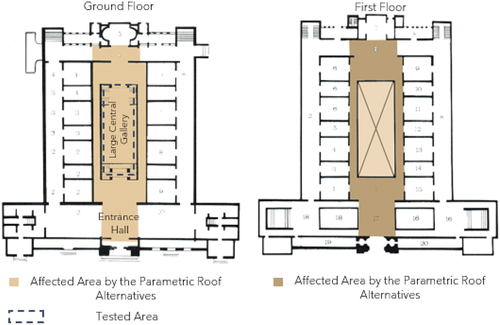
Participants observed the different roof alternatives through the Virtual Reality glasses, then a questionnaire that included pictures of each roof was distributed among the participants to collect responses on the perceived mood and emotional activity according to each suggested parametric roof design that differ in color, form, light, and patterns. The questionnaire targeted 67 random museums’ visitors of three different age groups: young adults 18–25 (52%), adults 25–40 (16%), and seniors 40–60 (32 %). The study attempted to represent the age group pattern of typical visitors who visit historical museums based on prior research. The questionnaire was divided into three sections: the first section was about the age group, and whether the participants have visited the museum before or not. The second section of the questionnaire was about the perceived interactive mood of the participants through a Semantic Differential Likert scale. This part included the three rendered photos of the different roofs, followed by four questions asking about the perceived mood to know how participants’ interactive emotional spatial experience was affected. The first two questions asked about the ‘Dramatic’ and ‘Energetic’ feelings, which are related to the interactive engaging moods, while the other two questions asked about the ‘Pleasing’ and ‘Calmness’ feelings, which are related to the interactive relaxed moods. The final section of the questionnaire consists of a multiple-choice question regarding interactive emotional activity and a final question that asked participants whether they thought they were in an immersive, minds-on, or aesthetic setting.
Procedures of the virtual reality experiment setup
The interior of the main hall of the Egyptian Museum in Cairo study model was created, rendered, and tested using Revit as the 3D modeling tool and Lumion as the rendering software as shown in . CloudPano 360 was used as the phone application to split the screen of the virtual reality glasses into two screens, a right and a left one as shown in . Then the phone was put into the VR glasses, so the participants could visualize the different roof alternatives. The existing roof design of the main hall was modeled then, the first parametric design roof alternative the ‘Flat Bulky Parametric Roof’ was designed using a shape grammar as shown in . A triangular unit was developed, and then multiple triangular shapes of different sizes and orientation were developed and placed in repetitive forms. The small sized triangular units were positioned at the center of the roof to allow diffused natural light in the exhibition hall while the medium-sized triangular shapes were placed along the sides of the roof to light the sculptures underneath, and the larger triangular shapes were placed at the end to highlight the main statue located at the end of the main hall. This resulted in an evident center of distribution at the center of the roof. While the second roof alternative was the ‘Dynamic Light Parametric Roof’ design, and another shape grammar was applied as shown in . The main unit was a rhombus shape, then several units of different sizes were placed in a repetitive form. The smaller units were positioned on the roof’s depressed areas while the larger shapes were placed on the rest of the roof to provide a diversity of light pattern reflections. This produced several centers of distribution in the lower areas of the dynamic roof design.
Figure 8. View of the Virtual Reality glasses: the existing Egyptian museum roof right and left eye image (developed by the author, 2023).
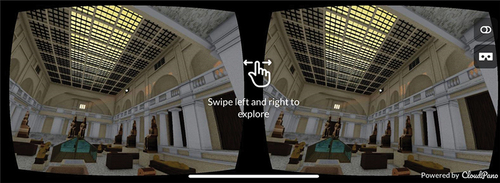
Figure 9. The Flat Bulky parametric roof shape grammar and algorithm (developed by the author, 2023).

Figure 12. The Dynamic light parametric roof shape grammar and algorithm (developed by the author, 2023).

Discussion of questionnaire results
According to the questionnaire results and analysis, it was concluded that each parametric roof design induced different moods and interactive emotional activity as shown in . Participants’ responses regarding their moods in the current roof of the Egyptian Museum in Cairo induced a neutral mood throughout the space. However, the presence of different sizes of the triangular shape in Alternative 1 ‘Flat Bulky Parametric Roof’ conveyed a sense of flatness and bulkiness yet generated an interactive comfortable mood as shown in , as individuals became more focused on the emotional activity as the small sized openings merged into the atmosphere to illuminate certain areas in the exhibition hall. Alternative 2 ‘Dynamic Light Parametric Roof’ is a parametric roof with wide sized openings that allowed more natural light to enter the exhibition hall. This generates an interactive engaged atmosphere in which individuals become part of an immersive environment that is entirely lit through the wide parametric openings. This indicated that the implementation of the parametric roof design could enhance visitor’s museum experience by altering the type of parametric roof design based on the needed spatial experience, either an interactive relaxing or interactive engaging spatial experience.
Table 1. The Virtual Reality experimental findings (developed by the author).
Design guidelines of interactive emotional spatial experiences
The following guidelines were deduced from the prior literature and the survey questionnaire data analysis after conducting the VR experiment. These guidelines outline the features and factors that could be employed when creating exhibition spaces to induce a certain interactive emotional experience based on the tested parametric alternative roof designs. All interior factors interact with one another as colors, textures, form, light, patterns, and heights of the space aid in the development of diverse atmospheres and moods that generate different interactive emotional spatial experiences. These guidelines define the elements and variables that could be used to create these certain spatial experiences, as follows:
Interactive relaxing spatial experience
To create an interactive relaxing spatial experience that would result in a pleasing, calm, peaceful, and serene mood, these guidelines are suggested to be followed, as shown in :
Parametric Design Criteria:Centre of distribution, repetitive form, different shapes and sizes and a statistical algorithm (shape grammar) should be fulfilled.
Design Features should include keywords such as flat, heavy, and bulky.
Colors used should be of high contrast with each other.
Form should be a narrow space.
The space should be of a high height.
Light should be of low contrast that is dim and subtle.
Size of openings should be small.
Interactive emotional activities should be minds on and aesthetic.
Table 2. Interactive relaxing spatial experience guidelines (developed by the author).
Interactive engaging spatial experience
To create an interactive engaging spatial experience that would result in a dramatic, energetic, exciting, and interesting mood, these guidelines are suggested to be followed, as shown in :
Parametric Design Criteria:Centre of distribution, repetitive form, different shapes and sizes and a statistical algorithm (shape grammar) should be fulfilled.
Design feature should include keywords such as dynamic, light, and wavy.
Colors used should be of low contrast with each other.
Form should be spacious with a high height.
Height of the space should also be high.
Light should be bright and clear in space.
Pattern openings should be wide.
Interactive emotional activities should be immersive environment and aesthetic.
Table 3. Interactive engaging spatial experience guidelines (developed by the author).
Conclusions and future studies
After analyzing the data regarding the museum’s parametric design, interior design factors and exhibition interactive emotional spatial experience, and moods. It was concluded that the emotional interactive activities have the greatest impact on visitors since their moods can alter by implementing high or low arousal moods that generate diverse experiences. Moreover, modifying interior design factors such as color, form, light, patterns, and texture in interior roof designs provide a variety of spatial emotional interaction experiences. As parametric design aims to solve design challenges using various algorithms, criteria, and phases, it was found that designing a parametric roof with small openings of specific patterns in a narrow high contrasted colored space resulted in an interactive relaxing spatial experience, while designing a parametric roof with wide openings in an open low contrasted colored space resulted in an interactive engaging spatial experience.
The research approach has some limitations; however, the research tried to reduce the impact of these limitations on the results. Although some perception senses could be tested through VR, as visual perception factors such as the colors, form, light, and patterns. Yet, some other perception senses were not tested as touch and sound. Also, the experiment could not be implemented in the ‘Pre-Test Pro-Test’ technique, where participants would take a questionnaire after testing each roof separately by VR as participants wanted to modify their responses after experiencing other alternatives. However, distributing the questionnaire after the participants were tested on the three roofs together, made them instantly feel the difference in experience of each roof providing genuine and relatively accurate feedback.
Furthermore, this study was conducted on a museum in the Egyptian context only, so another context could be tested to acquire more generalized results. Although the applied study only involved historical museums to fill the gap the research found of low interactive spaces in historical museums because of its formal context and the presence of valuable physical displayed items, future studies would be extended to cover other types of museums, such as art and science museums. The research suggests some possible future studies for enhancing the design of the spatial experience of existing museum exhibition halls. For instance, further experiments that test the sound perception to determine its effect on the spatial interactive emotional experience would be valuable. Also, developing experiments that test the touch sense such as the presence of different textures to determine their effect on visitor’s mood, emotional activity, and satisfaction in museums. Moreover, since this study focused solely on roofs, future studies can focus more on combining different interior design elements such as walls and floors in the parametric design process. In addition to investigating their effect on the interactive spatial emotional experience and mood in historical museums.
Disclosure statement
No potential conflict of interest was reported by the author(s).
References
- Chen KTN. The motivations of visitors for visiting museums: a comparative study of museum visitors in Western countries, Malaysia and Thailand. Assoc Private Higher Educ Inst Of Thailand (APHEIT). 2015 July;4(2):100–114.
- Salama AM, 2001. Nachar-Segeeny Museum: balancing and harmonizing the receptacle and spectacle. Medina Magazine, pp. 66–71.
- Sikes KM. Making Your Own Meaning: Designing Constructivist Interactive History Exhibits [ MSc Thesis]. Greensboro: University of North Carolina; 2012.
- Fino JR. The effects of human/object interaction on museum visit experience satisfaction [ MSc Thesis]. Clemson: Clemson University; 2008.
- Moury AJ, 2021. Interactive Elements In Museum Design: Why New Generation Are Less Interested In Visiting a Museum. [cited 2022 Dec 18]. [Online] Available at: https://www.researchgate.net/publication/354652278.
- Marzouki SY. Studying the factors affecting the promotion of museum visits applied to Egypt. J Assoc Of Arab Univ For Tourism And Hospitality (JAAUTH). 2022;22(1):343–379.
- Salama AM, Salingaros NA, MacLean L. A multimodal appraisal of Zaha Hadid’s Glasgow Riverside Museum—criticism, performance evaluation, and habitability. Buildings. 2023;13(1):173. doi: 10.3390/buildings13010173
- Anderson SP, 2011. Seductive Interaction Design: Creating Playful, Fun, And Effective User Experiences (Voices That Matter). Available at: https://www.researchgate.net/publication/259823177
- Rahimi FB, Levy RM, Boyd JE, et al. Human behaviour and cognition of spatial experience; a model for enhancing the quality of spatial experiences in the built environment. Inter J Ind Ergon. 2018;68:245–255. doi: 10.1016/j.ergon.2018.08.002
- Eldamshiry KK, Hesham M. Museum visitors learning identities interrelationships with their experiences. Cairo: Green Heritage, Chance - Change - Challenge; 2018. p. 490–500. https://www.researchgate.net/publication/323987626_Museum_Visitors_Learning_Identities_Interrelationships_with_Their_Experiences
- Forrest R. Design Factors in the Museum Visitor Experience [ PhD Thesis]. Queensland: The University of Queensland; 2014.
- Lara AI. Interactive public “art-chitecture”: engaging the city and its inhabitants [ MSc Thesis] Greensboro: University of North Carolina; 2010.
- Morsi NK, Mansour Y, Kamel S, et al. 2018. The Cultural Message Between The Lines Of The Jewish Museum Observing The Visitors’ Experience Through Thick Description. [cited 2023 February 25]. [Online] Available at: https://www.researchgate.net/publication/332188571
- Gorton AE. Is Wall Color Significant to Museum Visitors? Exploring the Impact Wall Color in an Exhibit has on the Visitor Experience [ MA Thesis]. Washington DC: University of Washington; 2017.
- Ahmady Y, Kaluarachchi Y. The Influence of Lighting settings on museum’s Brand image and Human satisfaction in exhibition halls using Virtual Reality. In: Ahram T, Taiar R, Langlois K Choplin A, editors Human interaction, emerging technologies and future applications III. IHIET 2020. Vol. 1253. Cham: Advances in Intelligent Systems and Computing; 2020. pp. 103–108.
- Ahmady Y, Shimy I, Mahmoud NA. A study of the impact of parametric façade openings’ design on thermal comfort and Energy Consumption of Office spaces in Egypt using simulation based techniques. MSA Engine J. 2023;2(3):173–184. doi: 10.21608/msaeng.2023.309315
- Al-Azzawi T, Al-Majidi Z, 2021. Parametric architecture: the second international style. 4th International Conference on Engineering Sciences (ICES). Kerbala, Iraq, IOP Conf. Series: Materials Science and Engineering.
- Al-Bqour N. Parametric thinking for designing structures in contemporary architecture. Int J Sci Eng Res. 2020;11(6):518–525.
- Alhawty EM. Parametric design between design and application in contemporary architecture. J Arch Arts Humanistic Sci April. 2022;7(4):78–94.
- ArchDaily, 2018. Louvre Abu Dhabi/Ateliers Jean Nouvel. [Accessed 2023 February 19] [Online] Available at: https://www.archdaily.com/883157/louvre-abu-dhabi-atelier-jean-nouvel
- Çolak BB, Ayçam I, Soyluk A. Parametric design tools for the design of energy efficient buildings. Ankara, s.n. 2021;57–72.
- Farouk A, Eldaly H, Dewidar K. Parametric design as a tool for performative architecture. J Al Azhar Univ Engine Sect. 2019 January;14(50):148–157. doi: 10.21608/auej.2019.28490
- Fino JR. The effects of human/object interaction on museum visit experience satisfactions [ MSc Thesis]. Clemson: Clemson University; 2008.

